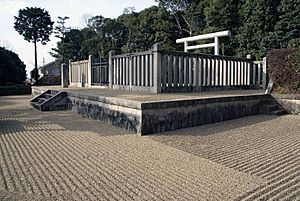Emperor Yōmei facts for kids
Quick facts for kids Emperor Yōmei用明天皇 |
|||||
|---|---|---|---|---|---|
 |
|||||
| Emperor of Japan | |||||
| Reign | 3 October 585 – 21 May 587 | ||||
| Predecessor | Bidatsu | ||||
| Successor | Sushun | ||||
| Born | 12 October 540 | ||||
| Died | 21 May 587 (aged 46) | ||||
| Burial | Kōchi no Shinaga no hara no misasagi (河内磯長原陵) (Osaka) | ||||
| Spouse | Anahobe no Hashihito | ||||
| Issue among others... |
Prince Shōtoku | ||||
|
|||||
| House | Imperial House of Japan | ||||
| Father | Emperor Kinmei | ||||
| Mother | Soga no Kitashihime | ||||
| Religion | Shinto | ||||
Emperor Yōmei (用明天皇, Yōmei-tennō, 540 – 21 May 587) was the 31st Emperor of Japan, according to the traditional order of succession. He ruled for a very short time, from 585 until his death in 587.
Contents
Emperor Yōmei's Reign
Yōmei was also known as Tachibana no Toyohi no Mikoto (橘豊日尊) in ancient Japanese records. He was sometimes called Prince Ōe or Prince Ikebe, named after the palace where he lived. He became emperor after his half-brother, Emperor Bidatsu, passed away.
Two very powerful leaders, Mononobe no Moriya and Soga no Umako, kept their important jobs during Emperor Yōmei's rule. Umako was Yōmei's cousin. These two families, the Mononobe and the Soga, were often rivals.
Becoming Emperor
- 585: Emperor Bidatsu died. His younger brother, Yōmei, then became the new emperor.
At that time, the title "Emperor" (tennō) wasn't commonly used yet. Instead, Yōmei was likely called Sumeramikoto or Amenoshita Shiroshimesu Ōkimi (治天下大王). This means "the great king who rules all under heaven." He might also have been called the "Great King of Yamato."
Emperor Yōmei's reign lasted only two years. He died when he was about 46 or 47 years old.
Conflict After His Death
- 587, in the 4th month: Emperor Yōmei died. His body was prepared but not immediately buried.
- 587, in the 5th month: A big fight broke out over who would become the next emperor. Mononobe no Moriya, who supported the traditional Japanese religion called Shinto, fought against the supporters of Buddhism. The Buddhist side was led by Prince Shōtoku (Yōmei's son) and Soga no Umako. The Buddhist side won this conflict.
- 587, in the 7th month: Emperor Yōmei's body was finally buried.
Because his reign was so short, Emperor Yōmei didn't make many big changes. However, he supported Buddhism, which caused tension with those who followed Shinto. According to old Japanese writings, Emperor Yōmei believed in both religions.
Mononobe no Moriya, a strong supporter of Shinto, tried to take the throne with Emperor Yōmei's brother, Prince Anahobe, after Yōmei's death. Even though it was said Emperor Yōmei died from an illness, some people wonder if he was actually killed by Moriya and Prince Anahobe because his reign was so brief and there was a plot to seize power.
Emperor Yōmei's Burial Place
The exact location of Emperor Yōmei's grave is known. He is honored at a special memorial Shinto shrine called a misasagi in Osaka.
The Imperial Household Agency looks after this site. It is officially named Kōchi no Shinaga no hara no misasagi.
Family Tree
Emperor Yōmei was the fourth son of Emperor Kinmei. His mother was Soga no Kitashihime.
In 586, Emperor Yōmei married his half-sister, Princess Anahobe no Hashihito (穴穂部間人皇女). She was the mother of four of his sons, including the famous Prince Shōtoku.
- Empress: Princess Hashihito no Anahobe (穴穂部間人皇女, d.622), daughter of Emperor Kinmei
- Second Son: Prince Umayado (厩戸皇子), later known as Prince Shōtoku, who became a very important regent.
- Fourth Son: Prince Kume (来目皇子, d.603)
- Fifth Son: Prince Eguri (殖栗皇子)
- Sixth Son: Prince Mamuta (茨田皇子, 579-643)
- Concubine: Soga no Ishikina (蘇我石寸名), daughter of Soga no Iname
- First Son: Prince Tame (田目皇子)
- Consort: Katsuragi Hiroko (葛城広子), daughter of Katsuragi no Atahe
- Third Son: Prince Maroko (当麻皇子, 574-586)
- Princess Sukatehime (酢香手姫皇女)
Emperor Yōmei had three main partners and seven imperial children in total.
See also
 In Spanish: Yōmei Tennō para niños
In Spanish: Yōmei Tennō para niños


